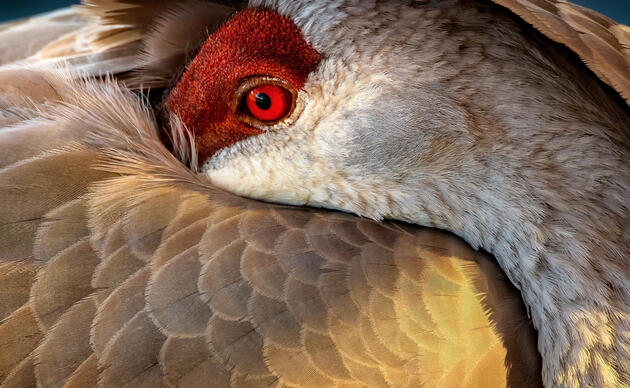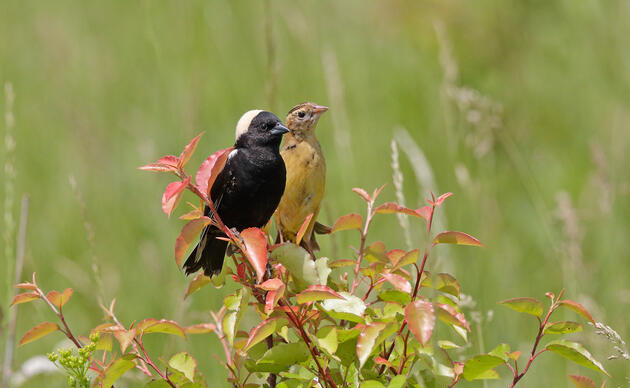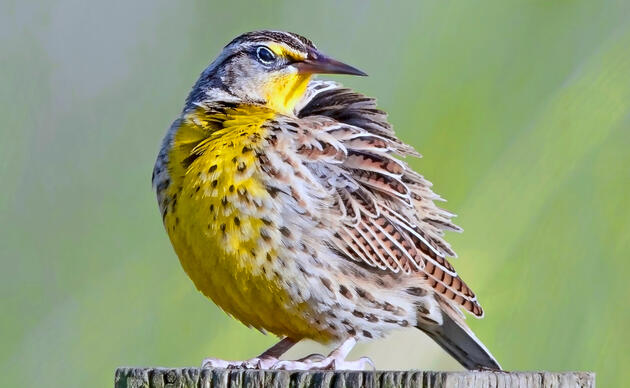Our projects focused on working lands are part of a strategic conservation priority within the National Audubon Society. Working land strategies are made possible through collaboration with partners and landowners, together we aim to improve the quality of habitat on privately managed land. By providing financial and technical assistance through the Prairie Management Toolbox, Audubon Conservation Ranching, Edward M. Brigham Alakali Lake Sanctuary, and the Conservation Forage Program. This past year we improved wildlife and bird habitat on 63,941 acres.
Edward M. Brigham Alkali Lake Sanctuary (Brigham Sanctuary)
Audubon Dakota manages the 2300-acre Edward M. Brigham III Alkali Lake Sanctuary for birds, other wildlife and people to thrive. The Edward M. Brigham Alkali Lake Sanctuary is a popular wildlife observation site, especially within the birding community where Sharp Tailed Grouse have a lek and every year can be spotted performing their mating ritual. The sanctuary has public access for seasonal recreational fishing on the 1,000-acre lake where wood ducks are commonly sighted. A highlight for 2022 included restoring 407 acres, completing our restoration goal of 595 acres over the last four years which benefits a variety of species including the Chestnut-collared Longspur which can often be heard in the summer singing its flight song over the prairie. This past May over 20 conservation partners joined us at Brigham Sanctuary for a prescribed fire school with partner presentations and a hands-on fire demonstration.
The North Dakota Conservation Forage Program (CFP)
The North Dakota Conservation Forage Program (CFP) works with North Dakota's producers to re-establish grasslands on marginal cropland to improve forage availability and quality benefiting grassland and migratory birds. By providing support through financial and technical assistance to landowners, CFP aims to accelerate grassland restoration and improve overall soil health across the state. Enrolled acres benefit the landowner and livestock, as well as grassland birds and native wildlife while protecting North Dakota's air and water quality for future generations. Land enrolled in CFP benefit grassland birds including the Upland Sandpiper, priority bird species – Swainson’s Hawk, and the Greater Prairie Chicken, a grassland bird known for foraging mostly on the ground, occasionally in trees and facing decline due to loss of habitat. A pilot project launched in 2021, so far 1,300 acres have been seeded and another 1,300 acres are in progress to be completed in the Spring of 2023.
Prairie Management Toolbox
The Prairie Management Toolbox provides financial and technical support for grazing infrastructure for private landowners. Funding for the program was provided by the North Dakota Outdoor Heritage Fund (OHF) and the National Fish and Wildlife Foundation, which has allowed Audubon Dakota to enhance over 18,000 acres of rangeland. Customizing a habitat management plan and through financial and technical assistance, we partner with landowners to meet their specific land and infrastructure needs. This past year we completed seven projects on 3,234 acres in North Dakota and restored 3,700 acres across three projects in South Dakota, benefitting wildlife including the South Dakota State Bird, the Ring-necked Pheasant. Projects included fencing and water infrastructure for grazing management, grassland restoration, and invasive tree clearing.
Audubon Conservation Ranching
To combat the negative effects of grassland degradations—and to keep grass on the landscape—Audubon launched the Audubon Conservation Ranching Initiative in 2009. This market-based conservation approach offers incentives for good grassland stewardship through a certification process and ACR label on beef products.
Our range ecologists work with ranchers and landowners to develop Habitat Management Plans that implement regenerative grazing and other Bird-Friendly practices, such as controlling invasive species and native plant seeding. By mimicking America’s historic bison herds, regenerative grazing invigorates diverse plant communities and supports nutrient cycles that rebuild soil and conserve water. We measure the effectiveness of these practices by monitoring bird diversity and abundance, vegetation change, and soil health.
Nationally, this program continues to gain momentum and expand. Most recently, our Audubon Dakota team enrolled seven ranches this past year to add 63k acres of certified bird-friendly habitat into the program. Additionally, our Range Ecologists continue to provide technical assistance to existing ACR ranches, and this year they updated seven habitat management plans impacting 27,000 acres. These efforts further our reach and sustain our commitment to enhancing and restoring bird and wildlife habitat.











